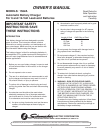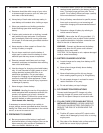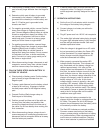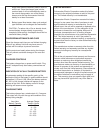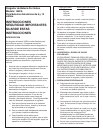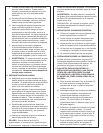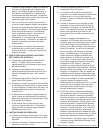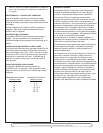
3
c) Check polarity of battery posts. Positive battery
post is usually larger diameter than the Negative
post.
d) Determine which post of battery is grounded
(connected) to the chassis. If negative post is
grounded to the chassis (as in most cases), see
Item E. If Positive post is grounded to the
chassis, see Item F.
e) For negative grounded vehicle, connect Positive
clamp from charger to Positive ungrounded
post. Connect Negative (Black) clamp to vehicle
chassis or engine block away from battery. Do
not connect to carburetor, fuel lines or sheet
metal body parts. Connect to a heavy-gauge
metal part of the frame or engine block.
f) For positive-grounded vehicle, connect Nega-
tive (Black) clamp from charger to ungrounded
Negative (Black) post of battery. Connect
positive (Red) clamp to vehicle chassis or
engine block away from battery. Do not connect
to carburetor, fuel lines, or sheet metal body
parts. Connect to a heavy-gauge metal part of
the frame or engine block.
g) When disconnecting charger, disconnect at wall
receptacle, remove clamp from vehicle chassis
and then remove clamp from battery post.
16. FOLLOW THESE STEPS WHEN BATTERY IS
OUTSIDE OF VEHICLE.
a) Check polarity of battery posts. Positive battery
post is usually a larger diameter than the
Negative post.
b) To keep a safe distance from the battery, attach
at least a 24-inch long, 18-gauge or heavier
insulted jumper cable to the Negative battery
post.
c) Connect Positive (Red) charger clamp to
Positive post of the battery.
d) Position yourself and free end of the cable as
far away from the battery as possible, then
connect the Negative clamp to the free end of
the cable. Do not face battery when making this
final connection.
e) When disconnecting charger, always do so in
reverse sequence of connecting procedure and
disconnect the first connection while as far away
from the battery as possible.
f) A marine (boat) battery must be removed and
charged on shore. To charge it on board re-
quires equipment specially designed for marine
use.
17. OPERATION INSTRUCTIONS
a) Set the 6 and 12 volt selector switch to match
the voltage of the battery being charged.
b) Connect charger to a battery as outlined in
Section 15 or 16.
c) Plug AC power cord into 120 AC volt receptacle.
d) The amber light indicates battery being charged
the green light indicates battery is fully charged
and the red light indicates trouble. See more
detailed explanation below.
e) When the charger is plugged into an AC outlet
but not connected to a battery the Green LED
will be illuminated. For proper operation, the
battery charger must be plugged into an AC
outlet and connected to a battery.
f) When properly connected the amber LED
indicator should illuminate. This indicator will
stay illuminated until the battery voltage has
reached approximately 14.4 volts and the
charge current has decreased to 0.5 amps. At
this point, the amber indicator turns off and the
green indicator turns on. Also occurring at the
same time, the internal voltage reference of the
charger will change in order to maintain the
battery voltage at 13.2 volts. At this lower
voltage charge, current is typically a few milli-
amperes (.001 ampere). Under this condition
most all batteries can be left charging indefi-
nitely. While in the maintain mode, if the battery
was loaded 0.5 amps or greater the charger will
reset to the full charge state until the above
conditions once again meet.
g) Never leave the battery connected to the
charger while the charger is unplugged from the
AC outlet. The reason for this is the charger
draws a few milliamperes from the battery which
will eventually rundown the battery.
h) The Red LED indicates an overload condition.
Common causes are shorting of the battery
clamps, reverse-polarity connection to a battery
or a problem battery. Other circumstances that
could cause an overload condition: Charging
two or more batteries in parallel and batteries



